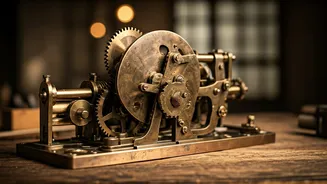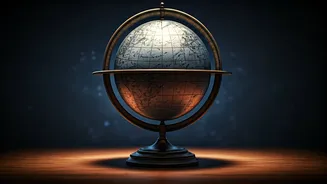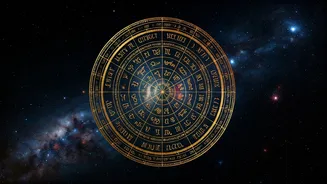Ancient Tech Unveiled
Many gadgets and systems that feel modern are based on concepts that date back centuries, even millennia. The evolution of technology has been a continuous
process. Examining these technologies reveals the enduring impact of human ingenuity. Several technologies, like the abacus, are still in use today. The idea that all modern innovations are truly recent is challenged by the deep historical background of familiar items. These ancient roots demonstrate both the progression and adaptability of human knowledge, as well as the timeless nature of particular core concepts.
Calculating with Abacuses
One of the oldest examples is the abacus, still used in educational settings and some businesses. This tool, essential for arithmetic, goes back to ancient civilizations such as Mesopotamia. It demonstrates that the core principles of computation existed long before electronic calculators and computers became a reality. The abacus highlights the ability of humans to develop systems that are both effective and enduring, even without access to advanced materials or digital technology. Its survival is a testament to its value and user-friendliness.
The Simple Pencil's Past
The pencil, a ubiquitous tool, has a history dating back to the 16th century. The discovery of a large graphite deposit in England created the need for an efficient way to use the material for writing. Early pencils were crude, but the basic form has survived largely unchanged. The way we still use pencils today is a tribute to human innovation. The evolution of the pencil, from its initial form to modern versions, shows how basic concepts are refined over time. These refinements include things such as erasers and the introduction of different grades of hardness.
Clocks and Their Time
Clocks are indispensable in modern life, but their origin is ancient. Early clocks, such as sundials and water clocks, provided a means of tracking time well before the mechanical versions appeared. Mechanical clocks, developed in medieval Europe, were a breakthrough. The spring-driven clock represented a leap in timekeeping technology. This evolution highlights a human desire to measure and understand the passage of time. These advancements in clock technology affected many aspects of life, including navigation, agriculture, and religious practices.
Paper and the Written Word
Paper, a crucial component of communication and record-keeping, has its origins in ancient China. The process of making paper involved creating a durable surface for writing, a breakthrough that transformed how cultures documented knowledge. Early paper was made from materials such as tree bark and cloth fibers. The invention of paper led to the widespread availability of books and other written materials. The influence of paper on the spread of ideas and the preservation of culture remains clear.
The Printing Press Story
The printing press, created by Johannes Gutenberg in the 15th century, changed the world forever. Before that, books were laboriously hand-copied, which limited the availability of knowledge. Gutenberg's invention made it possible to produce books much more quickly and in larger quantities. This led to increased literacy, the growth of new ideas, and the Renaissance. The printing press's effect on culture and the spread of information made a lasting impact on society.
The Camera's Origins
The concept of capturing images has its roots in the ancient Greek concept of the 'camera obscura', or dark room. This primitive camera, using a pinhole to project an image, laid the groundwork for the modern camera. Over centuries, these techniques evolved, and the use of lenses and light-sensitive materials led to modern photography. The camera's evolution highlights humanity's continuous efforts to record and share visual experiences. Modern technology continues to build on these early innovations.
Sewing Machines' Early Days
The sewing machine, a time-saving marvel of modern life, has an interesting history. Early designs were developed in the 18th century. These rudimentary machines were intended to mechanize the process of stitching. These early inventions show how humans have always sought ways to improve efficiency. The development of sewing machines demonstrates how ideas and technology improved over time, leading to mass production of clothing and other textile items.
Refrigeration’s Cold Start
Refrigeration, a key technology for food preservation, also has deep historical roots. Ancient civilizations developed ways to keep food cool, using ice and other natural methods. In the 19th century, mechanical refrigeration was born. These early refrigerators used processes like compression to produce cold. The development of refrigeration demonstrates the human need to preserve food and manage resources. This led to many advancements in fields like food storage and transport.
Other Surprising Tech
Several other modern technologies have ancient roots. For example, the concept of a postal system, designed to transport messages, dates back to ancient empires. The concept of using a wheel for transport and tools is very old. Even the basic idea behind the modern computer can be traced to early calculating machines. Examining these surprising technologies highlights the continuous progression of human innovation, with new advancements building on older ideas and concepts.
Legacy and Evolution
These 21 technologies demonstrate the lasting legacy of past innovators. The gadgets and systems we use today are often based on centuries-old ideas, reflecting the persistent human desire to create and enhance our lives. The ability to build on previous discoveries is key to technological advancement. This rich history reveals that innovation is not just a modern phenomenon; instead, it is a constant process of building on what came before. The fact that older inventions still influence our daily lives is a testament to the ingenuity and the lasting impact of early pioneers in tech.















